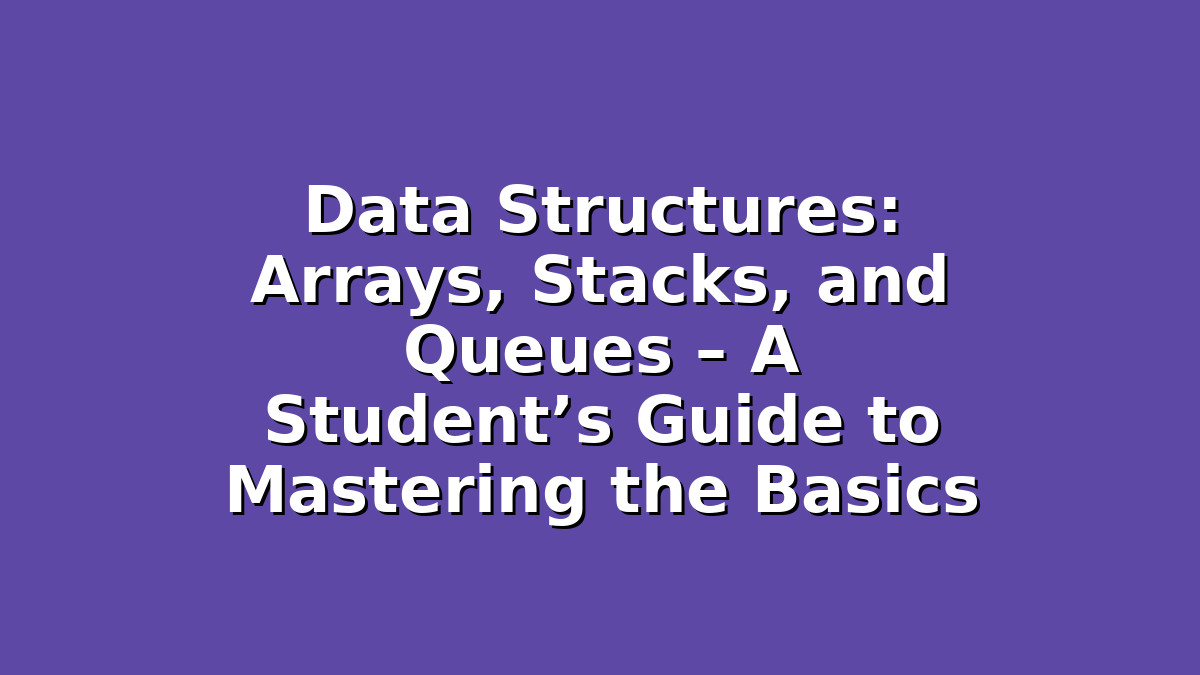When preparing for computer science exams or coding interviews, understanding fundamental data structures is essential. Among the most important concepts to grasp are arrays, stacks, and queues. These foundational structures not only help you organize data efficiently but also serve as building blocks for more complex algorithms and systems. If you’re a student gearing up for exams or simply aiming to strengthen your programming skills, this guide will walk you through these three data structures with clear explanations, practical examples, and effective study tips. Let’s dive in!
Understanding Arrays: The Building Blocks of Data Storage
Arrays are one of the simplest yet most powerful data structures you’ll encounter. Think of an array as a collection of elements arranged in a specific order, where each item can be accessed directly via its index. This direct access makes arrays an ideal choice for storing data when you know the size in advance and need fast lookups.
Key Characteristics:
– Fixed size (in most languages).
– Elements stored in contiguous memory locations.
– Indexed from zero (usually).
Why Arrays Matter for Students:
Arrays help you grasp how data is stored in memory and accessed quickly. Many algorithms, such as sorting and searching, rely on arrays as their backbone. During exams, questions about array manipulation—like reversing an array, finding the largest element, or merging two arrays—are common.
Study Tips for Arrays:
1. Visualize the array: Draw arrays on paper or use online visualization tools to see how elements are placed and accessed.
2. Practice indexing: Write code snippets to access, update, and iterate over arrays. Pay special attention to zero-based indexing errors.
3. Understand time complexity: Know that accessing any element by index is O(1), but inserting or deleting elements might be O(n) because of shifting.
4. Solve problems: Websites like LeetCode or HackerRank have numerous array problems. Start with easy ones and gradually increase difficulty.
Example:
“`python
arr = [10, 20, 30, 40, 50]
print(arr[2]) # Outputs 30
arr[4] = 60 # Update last element
“`
—
Mastering Stacks: Last-In, First-Out Made Simple
A stack is a collection that follows the Last-In, First-Out (LIFO) principle. Imagine a stack of plates: you place plates on top and remove the top plate first. This behavior is crucial in many computing scenarios, such as function call management, undo operations in text editors, and expression evaluation.
Key Characteristics:
– Operations: `push` (add), `pop` (remove), and `peek` or `top` (view the top element).
– LIFO order.
Why Stacks Matter for Students:
Understanding stacks helps you deal with recursion, backtracking problems, and parsing expressions. Exam questions often ask you to implement a stack or solve problems like balancing parentheses or evaluating postfix notation.
Study Tips for Stacks:
1. Implement your own stack: Use arrays or linked lists to build a stack from scratch. This reinforces how stacks work internally.
2. Trace stack operations: Use pen and paper to simulate `push` and `pop` sequences.
3. Solve classic problems: Practice with parentheses matching, reversing strings using stacks, or infix to postfix conversion.
4. Understand space-time tradeoffs: Know when stacks use O(n) memory and how operations mostly run in O(1) time.
Example:
“`python
stack = []
stack.append(1) # push
stack.append(2)
print(stack.pop()) # Outputs 2
print(stack[-1]) # Peek, outputs 1
“`
—
Exploring Queues: First-In, First-Out in Action
Queues are another fundamental data structure, embodying the First-In, First-Out (FIFO) principle. Picture a line at a ticket counter: the first person to arrive is the first to get served. Queues are used in scheduling, buffering, and handling asynchronous data.
Key Characteristics:
– Operations: `enqueue` (add at rear), `dequeue` (remove from front).
– FIFO order.
Why Queues Matter for Students:
Queues appear in breadth-first search (BFS), job scheduling, and managing resources. In exams, you might be asked to implement queues, use them to perform BFS, or simulate real-world scenarios.
Study Tips for Queues:
1. Understand queue operations: Practice coding enqueue and dequeue using arrays or linked lists.
2. Visualize flow: Draw diagrams showing how elements move through the queue during these operations.
3. Practice problems: Work on BFS problems in graphs, or simulate printer queues.
4. Learn circular queues: Understand how circular queues optimize space by connecting the end back to the start.
Example:
“`python
from collections import deque
queue = deque()
queue.append(10) # enqueue
queue.append(20)
print(queue.popleft()) # dequeue, outputs 10
print(queue[0]) # peek front, outputs 20
“`
—
Final Words: How to Study Arrays, Stacks, and Queues Effectively
Mastering arrays, stacks, and queues is a huge step toward acing your computer science exams and boosting your programming confidence. Here are some final study strategies to keep you on track:
– Practice consistently: Regular coding practice helps reinforce concepts and improves your problem-solving speed.
– Work on real problems: Apply these data structures to solve algorithmic challenges from trusted platforms.
– Use multiple resources: Videos, textbooks, and interactive tutorials can offer different perspectives that aid understanding.
– Form study groups: Explaining concepts to peers or working together on problems makes learning more engaging.
– Test yourself: Create flashcards for terminology and write mini-implementations from memory.
– Stay positive and persistent: Data structures might seem tricky at first, but with steady practice, you’ll master them!
Remember, these three data structures are not just academic topics but tools you’ll use throughout your programming journey. The effort you invest now will pay off in exams and real-world coding tasks alike.
Best of luck with your studies — keep pushing forward, and soon you’ll find arrays, stacks, and queues are second nature!
—

Responses